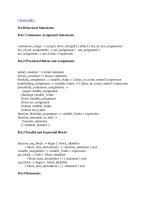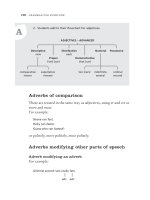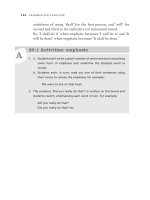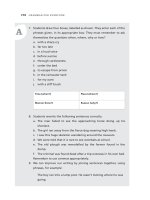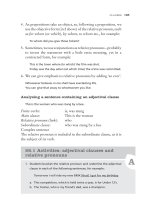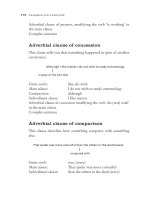Tài liệu Grammar for everyone part 3 ppt
Bạn đang xem bản rút gọn của tài liệu. Xem và tải ngay bản đầy đủ của tài liệu tại đây (132.43 KB, 7 trang )
David Crystal, author of The Cambridge Encyclopaedia of
the English Language, wrote, ‘In the popular mind, grammar has
become difficult and distant, removed from real life, and practised
chiefly by a race of shadowy people (grammarians) whose tech-
nical apparatus and terminology require a lengthy novitiate
before it can be mastered … It is a shame because the fundamental
point about grammar is so very important and so very simple.’
The final statement is the significant one. We need to show that
grammar need not be dry or tedious, but can be both fascinating
and relevant.
Some of you may have received no grammar instruction at all;
others may have been offered it in a random fashion, eclipsing
its true function. Grammar provides a whole cohesive system
concerning the formation and transmission of language. The
question is, how do we pass on this knowledge? Firstly we need
to understand it ourselves and, even better, develop that passion
and enthusiasm in our students.
4
G r A M M A r f o r e V e rY on e
I trip (verb) over the rug (noun) and then you say I’m clumsy (adjective)!
What is grammar?
We all use grammar from the time that we can speak in intelligible
sentences, because grammar deals with ‘the abstract system of
rules in terms of which a person’s mastery of his native language
can be explained.’
1
We assume that it all happens naturally and
are only confronted with the need to understand and define how
English works when we learn another language or attempt to teach
English to others.
So how might we define grammar? The simplest and perhaps
the truest definition is ‘a language to talk about language’. Just as
one cannot explain how a motor engine functions (or is failing to
function) without naming words for its parts and their specific
actions, so it is impossible to explore the function of words and the
part they play in forming meaningful language without a naming
procedure.
It is impossible, for example, to offer a meaningful explanation
for why we say ‘did it well’ rather than ‘did it good’ if there is no
shared understanding of the language for talking about language –
to explain that ‘good’ being an adjective qualifies a noun, e.g. ‘He
did a good job,’ but ‘well’, an adverb, is used for adding meaning
to a verb, e.g. ‘He did it well.’
The history of grammar
Whatever subject we are teaching, it becomes more interesting
and meaningful, both to us and to our students, when we know
something about its origin and history. This is no less true of
grammar.
The word ‘gramma’ meaning ‘letter’ has come down to us
in a path through several languages. In early times, the craft of
using letters and constructing messages with the use of symbolic
markings was seen to indicate magical powers, causing some early
1 Crystal, D., 1995, The Cambridge encyclopaedia of the English language,
Cambridge University Press, Cambridge.
5
b A c k G r o u n d A n d h i s t o rY
5
G r A M M A r – b A c k G r o u n d A n d hi st orY
scholars to be seen as dealers in witchcraft and consequently eyed
with suspicion. The word ‘glamour’, meaning a deceptive charm,
derived from the same source. However, in modern usage this
word has lost much of its detrimental connotation.
Of course, no one invented grammar – it was there all along,
an intrinsic part of the first meaningful speech uttered by human
beings and, likewise, of their first meaningful writings. But at
some point, interested scholars were inspired to make a study of
it and its systems, both for their own better understanding and to
enhance the language skills of their students – the same aim that
we, as teachers, have today.
The study of grammar is believed to have its origins in both
India and Greece. In India it was for the study of recited forms of
Sanskrit, and in Greece for the study of written language. It is the
latter that provides the source of our own studies.
Grammar and literacy are intrinsically bound. One of the first
to formulate a system of grammar was Dionysus Thrax, from
Alexandria. His ‘The Art of Letters’ required students to first learn
their letters in strict order (just as we do with our alphabet), then
proceed to letter combinations, forming syllables in increasing
length, from simple to complex word forms. Thrax’s grammar,
which he defined as ‘technical knowledge of the language of poets
and writers’, established a model for the teaching of all European
languages.
Through the following centuries, various scholars have set
their own mark on the development of grammatical thought.
Philosophers such as Aristotle and Socrates realised the impor-
tance of grammar for all forms of language expression, particularly
public speaking (rhetoric) and debate. A Roman, Marcus Varre,
produced 25 volumes on the subject, translating the Greek and
then applying the grammar to Latin. Interest then spread around
the world, with grammarians of other countries comparing the
features of their languages with those of Latin.
The best-known early English grammarian was Ben Jonson,
who also based his work on Latin. He made a particular study
6
G r A M M A r f o r e V e rY on e
of punctuation for which he had his own rather heavy versions
adhering to the theory that one should punctuate as one wishes
one’s work to be read or orally delivered, as well as to determine
meaning in a logical way.
Then the 1760s ‘witnessed a striking outburst of interest in
English Grammar’
2
and among the best-known grammars was that
of Robert Lowth, a clergyman and later Bishop of London. Lowth
sought to remedy the dearth of simple grammar textbooks, but he
earned criticism for judging the language as well as describing it.
His pedantic approach led to such oft-quoted prescriptions as the
inappropriateness of ending a sentence with a preposition.
Lowth’s work was followed by others, giving rise to the form-
ulation of basic grammar principles and agreement on some points
of usage. The principle of the supremacy of usage, which is still
supported today, was established by Joseph Priestley, who stated:
‘It must be allowed that the custom of speaking is the original and
only just standard of any language.’
3
In 1898, Nesfield and Wood co-authored the Manual of
English Grammar and Composition which ran concurrently with
Nesfield’s 1900 text An Outline Of English Grammar. Certainly
these would appear dull and tedious to most modern students, but
they do, nevertheless, provide excellent detailed explanations for
those of more linguistic bent.
2 Baugh, Albert C, & Cable, Thomas 1987, A history of the English language,
Routledge & Kegan Paul, London.
3 ibid.
7
G r A M M A r – b A c k G r o u n d A n d hi st orY
Teaching strategies
for the contemporary
classroom
Definitions and explanations
We know it – can we explain it? Because we know something, it
does not follow that we can explain it to others – especially to
a child who may learn in quite a different way from you – his
teacher. For example, take the concept of a syllable. Most of us
have some understanding of what a syllable is, but when asked
to show how one would explain it to students you might get
something like this:
‘It’s part of a word.’
But so is a letter!
‘It’s when you break it up …’
Similarly for a letter. ‘Try again,’ you say.
‘It’s got a vowel in it.’
Better, but so has any word!
Eventually you put it all together to give an accurate definition:
a unit of speech (consisting of) a word, or part of a word, containing
one sounded vowel. Or for adult students: a segment of speech,
uttered with one emission of breath (the breath is emitted with the
sounding of the vowel).
…
8
So, to teach about syllables we need first to be sure that we
understand what they are ourselves; then we need to put that
information across in the best way to suit the age and stage of
the students. This will require a full explanation of the definition,
which can be done with practical demonstrations such as clapping,
or feeling when the jaw drops for the utterance of the vowel.
Rule 1: Know your definition or at least have a good dictionary
handy so you can check.
Rule 2: Remember to give your definition (as the dictionary does)
in the same part of speech as the word being defined.
Rule 3: Keep the definition as simple as possible while maintaining
all aspects essential to accuracy.
Rule 4: Discuss with examples to increase understanding and
application.
Rule 5: Take note of words with two or more meanings, but the
same spelling (homonyms) such as chest, bulb.
Rule 6: Practise! And use the words in both oral and written
sentences.
Animating teaching strategies for all
learning styles
Often the mistake is made of assuming that what seems to be a
purely academic subject such as grammar can be taught only in
a dry unimaginative way. But this is far from true. Awareness of
the need for more active involvement in learning has come about
with the greater understanding of how the brain works, and the
accompanying recognition that people vary considerably in their
learning modes. In addition, the importance of teaching to the whole
brain through multisensory activities cannot be over-emphasised.
We know then that people learn in a variety of ways. Even
within one family we often see that what works with one child
may be useless for another. One may learn to read just by looking
at letters or matching words and pictures; a more auditory child
will absorb information principally by listening and repetition;
9
t e A c h i n G s t r At eG ie s fo r th e co nt eM po rA rY c l A s s r o o M
yet another needs motion and physical connection in order to
‘inbuild’ the information. So, while the more sedentary skills
of reading and writing are an essential component of grammar
education, active learning with kinetic exercises can play a vital
part in reinforcement, especially with younger age groups.
By delivering instruction in a variety of creative ways, using all
the channels to the brain, we are ensuring not only that all students
can benefit, but also that they will enjoy their lessons.
Gender differences
Though it was probably never in doubt, research techniques show
that boys, in general, are less inclined to sit at tasks for lengthy
periods. They prefer, and need, more physical activity.
4
This
may involve, firstly, varying activities centred on a learning unit
and, secondly, allowing more short breaks or including creative
activities for practice and reinforcement.
5
Sometimes, offering
choices is a good strategy, particularly with a mixed class.
Confident language mastery
Developing confident language skills is arguably the most
important outcome of our teaching procedure. The term ‘language
principles’ refers to a body of core essentials for understanding and
manipulating one’s language, and indeed, learning a foreign one.
Certain principles govern the use of every language and relate
to such things as word meaning (and accuracy), the arrangement of
words or word groups in a sentence (syntax), stress given to certain
parts of a word and, in most languages, the use of punctuation.
10
G r A M M A r f o r e V e rY on e
4 Cole, Martin 2001, ‘Equality boss hits special help for boys’, Courier Mail, 22
February; House of Representatives, Standing Committee on Education and
Training 2002, Boys: Getting it right, report on the inquiry into the education of
boys, [AGPS], Canberra.
5 Macmillan, Bonnie 1997,
Why schoolchildren can’t read, Institute of Economic
Affairs, London.

